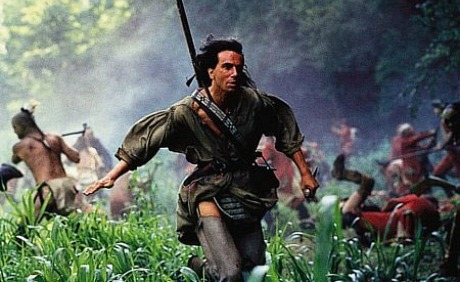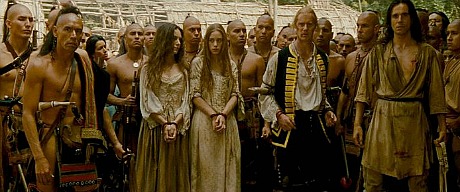I’ve seen Michael Mann‘s The Last of the Mohicans three times — once during the initial 1992 theatrical release, an expanded edition on a DVD a few years ago and then the definitive director’s cut Bluray in 2010.

The Bluray is the best version by far, but for some reason I’ve never managed to love Mohicans. I’ve always liked, admired and respected it but my heart goes out to Heat, The Insider, Collateral and Thief.
I nonetheless would have attended the special screening of the definitive director’s cut at L.A.’s American Cinematheque on Friday night, if no other reason than to listen to Mann talk about it with L.A. Times guy Geoff Boucher. In Contention‘s Kris Tapley did, however, and has provided a well-written report and an mp3 of the discussion.
“It’s the law and order of nature — as it gives way to the impositions of occupiers — that largely governs the tone and atmosphere of Mohicans,” Tapley writes. “The film is unique in Mann’s canon for its period trappings, but of a piece with his penchant for deep emotional currents that announce themselves only in the nuance of performance.
“Indeed, it is still the film’s sweeping romance, its epic sadness, its viscous sense of honor that resonates emotionally to this day.”
During the post-screening q & a Mann explained the difference between ’92 and the definitive director’s cut.
“I understand story better [now],” Mann told Boucher. “When I was doing the original in 1992, I wanted to jam or insert the audience into the narrative so that things would just happen and you kind of tried to find out where I am in context, kind of inductively. And that wasn’t really serving the story. There’s a hopefully much clearer path in this version. The story is presented in a more deductive way.”
The film was in a sense under-served, Mann feels, by James Fenimore Cooper‘s novel, a piece of arrogant Euro-revisionism which he called “not very good.” He said that the film was “saved” by a diary written by Louise-Antoine Comte de Bougainville “who later goes to Hawaii and discovers Bougainvillea, which we have all over Los Angeles — he wrote a diary of every single day of that whole French and Indian war campaign. And the diary reads — it’s ironic, it’s funny, it’s sarcastic, it’s fantastic. But it literally told us what happened every single day of August 1757.”

Tapley’s best observation: “A simple question [for Mann] yields a bounty of information, as if unlocking the door to a closet packed with ideas waiting to tumble out. He’s meticulous, and it’s not an affectation.”
Best Mann quote: “Daniel Boone could leave a populated area and spend two years in the wilderness, eat three meals a day and live. These were all techniques learned from the American Indians. So the idea was, which I firmly believe, if an actor can actually do the things of the person he’s portraying, he truly becomes that person. You do it, you own it…[and] as a director, that’s what you want. I’m interested in actors and actresses who are for real, who are adventurous, who are very ambitious, who see it as an adventure and are ready to kind of commit, not out of discipline or coercion but out of, ‘Why would you want to do it any other way?’ Who wouldn’t want to do it if you could?'”
Best IMDB Anecdote: “Many long nights were spent filming the siege scenes. Due to the expansive area involved, loudspeakers were installed around the battlefield and fort so directions could be easily given to the hundreds of cast and crew. One night after many long hours, Mann was heard to shout over the speakers, ‘What’s that orange light? Turn out that orange light!’ After a pause another voice (an A.D.?) came over the speakers stating, ‘That’s the sun, Michael.'”









